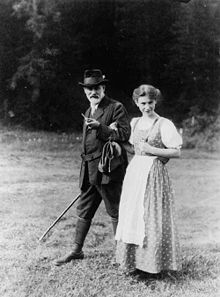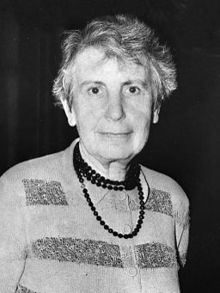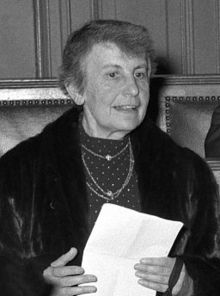Anna Freud
Anna Freud (born December 3, 1895 in Vienna , Austria-Hungary ; died October 9, 1982 in London ) was an Austrian - British psychoanalyst and the daughter of Sigmund Freud . She became known for her work on psychoanalytic pedagogy and child analysis on the one hand and on defense mechanisms on the other. In 1938, she fled to Great Britain with her parents and siblings and acquired British citizenship .
Life

Anna was the youngest of Sigmund and Martha Freud's six children . She got the same name as Sigmund Freud's sister Anna (1858–1955). This aunt Anna had married the merchant Eli Bernays in 1883, three years before Sigmund Freud married his sister Martha Bernays.
At the beginning of 1910, Anna's parents suspended school attendance. “Not only had she lost weight after an appendix operation, but also seemed a little too unreasonable to the family members in general.” From June 1910 she was treated by Ludwig Jekels, a friend and colleague of her father, in his private sanatorium in Bistrai. Her aunt Minna Bernay, who cured together with her and her sister Sophie in Bistrai, wrote to Sigmund Freud that Anna had gained weight, but was "still a little Meschuggenes". Dr. Jekels is against taking her back to Vienna and school. The older sister, with whom Anna lived in Vienna at the beginning of school because her parents were still traveling, said that Annerl was “a poor animal and torments herself terribly with everything”, but stated that she was “relative reason” the school ”. Anna took an exam in October because of the missing diploma for the previous school year and in July 1912 passed the high school diploma with distinction at the Cottage Lyzeum in Vienna.
Anna Freud first became a teacher and taught at the Billrothgymnasium in Vienna from 1917 to 1920 , but early on she was interested in psychoanalysis. She completed a training analysis with her father and ended up working as a psychoanalyst herself; In 1923 she opened her own practice at Berggasse 19 next to her father's premises.
As a loyal daughter, Anna Freud worked for her father as a secretary and assistant, organized his appearances, cared for the cancer patient and represented him at congresses. In the 1920s, like her father, she became friends with Lou Andreas-Salomé , a Russian-German psychoanalyst and confidante of Nietzsche and Rilke .
From about 1925 she lived with Dorothy Tiffany Burlingham , a New York millionaire heiress. However, both of them suggested a homosexual relationship. In 1931 they bought a weekend house in Hochroterd in the southern Vienna Woods. In 1937 they opened the “Jackson Day Nursery” on Rudolfsplatz in Vienna's 1st district.
After the annexation of Austria by Germany , Anna Freud was interrogated by the Gestapo in Vienna on March 22, 1938 . On June 4, 1938, Sigmund Freud, his wife Martha and their children, including Anna, fled to London with Dorothy and their four children. Anna's brother Ernst Ludwig Freud had emigrated there in 1933.
Anna Freud became a training analyst for the British Psycho-Analytical Society . After the death of their father in 1939, there were extremely controversial discussions between Anna Freud and Melanie Klein and their respective supporters, which concerned not only child analysis, but the entire direction of psychoanalysis. A split in the British Psychoanalytic Association was prevented with great difficulty. In addition to the two main groups, a third group of “independents” was formed.
In 1945 Anna co-founded the journal Psychoanalytic Study of the Child with others .
Anna Freud and her partner Dorothy Tiffany Burlingham founded the Hampstead Nurseries together with Josefine Stross , a home in which they looked after war children and orphans . In 1945 Anna Freud brought a small group of children from Theresienstadt to London. They were looked after and looked after under their supervision. Some children's memoirs have been published with their permission. Anna Freud herself wrote an article about her, which she published in 1951 in the magazine she founded.
After the Second World War , they expanded the nurseries : from 1947 the Hampstead Clinic for Children became an internationally renowned teaching institute for child therapy. In agreement with the British Psychoanalytical Society , the Hampstead Clinic was called The Hampstead Child-Therapy Clinic from the start , although the therapy method practiced and taught at the clinic was and is that of child psychoanalysis. Anna Freud headed the clinic as director from 1952. She gave its name to the renaming of the clinic, which is now known as the Anna Freud Center .
In the decades that followed, Anna Freud's work focused primarily on young people and children. Along with Melanie Klein, she is one of the founders of child analysis. In addition to her focus, the analysis of war-traumatized children, she also analyzed adults, including Marilyn Monroe .
After Sigmund Freud's death in 1939, Anna took over the legacy of her famous father, became the doyenne of psychoanalysis and spent a lot of time on lecture tours and congresses. She only visited Vienna in 1971 after she had fled: I was a Viennese with all my heart all my youth and felt very much connected to the city, much more than my father ever felt.
She lived in the Freud House in London until her death in 1982, after which a museum was set up there according to her wishes.
Anna Freud was cremated in Golders Green Crematorium , where her urn is next to those of her parents, other family members and that of Dorothy Burlingham.
In 2014 the Freudplatz in Vienna- Leopoldstadt (2nd district) was named after her and her father. The Sigmund Freud University of Vienna, founded in 2005, has been located there since 2015 . In Berlin, a vocational upper school center for social education bears her name.
Services
From 1927 to 1934 Anna Freud was Secretary General of the International Psychoanalytic Association (IPV). At their tenth congress from September 1st to 3rd, 1927 in Innsbruck , she gave a lecture on the topic of "Theory of Child Analysis".
Then in 1935 she became director of the psychoanalytic training institute in Vienna. With her book Das Ich und die Abwehrmechanismen , published in 1936, Anna Freud created a basic work in the field of ego psychology that is now part of the standard literature in psychoanalysis. It describes ten defense mechanisms known from psychoanalytic literature : repression , regression , reaction formation , isolation, undoing / denial, projection , introjection , turning against oneself , turning into the opposite, shifting the instinctual goal ( sublimation ).
Anna Freud adds to these complex types of defense gained from her own observation and practice , which can be considered mixed forms: identification with the aggressor (introjection and projection) and altruistic cession (projection and identification). The term altruistic assignment comes from Edward Bibring . Anna Freud writes: "The most beautiful and detailed example of such an altruistic assignment to the more suitable object can be found in the play Cyrano de Bergerac by Edmond Rostand ."
Quotes from The I and the Defense Mechanisms :
“The emergence of psychoanalytic doctrine from neurosis research makes it understandable that analytical observation has always been directed primarily towards the inner struggle between drive and ego, the subsequent states of which are the neurotic symptoms. The work of the child's ego to avoid discomfort in direct defense against impressions from the outside world belongs to normal psychology. Their consequences may be serious for the formation of the ego and character, but they are not pathogenic. Wherever we find this ego-achievement described in clinical analytical work, it does not appear as the actual object of the investigation, but is always only a by-product of observation. "
“But even there in infantile neurosis, where the defense was based on real fear [ie fear of the outside world], analytical therapy has a very good chance of success. The simplest and most unanalytical is the attempt by the analyst, after undoing the defensive process in the child himself, to influence reality, namely the child's educator, in such a way that there is less real fear. "
In recognition of her achievements, she was honored with a CBE medal by Queen Elisabeth II in 1967 , received an honorary doctorate from the University of Vienna in 1972 and was honorary president of the IPA from 1973 to 1982.
Little is known that Anna Freud also wrote fictional texts, which are kept in the Library of Congress in Washington and were first published in 2014.
Awards

- 1959: Member of the American Academy of Arts and Sciences
- 1964: Cultural Prize of Honor from the City of Munich
- 1967: Order of the British Empire (CBE)
- 1975: Great Gold Medal for Services to the Republic of Austria
- Since 2007 the University Clinic for Psychoanalysis and Psychotherapy at the Vienna General Hospital has organized the Anna Freud Lecture annually in cooperation with the Vienna Psychoanalytical Association .
Fonts (selection)
- Introduction to the technique of child analysis . Psychoanalytischer Verlag, Vienna 1927, ISBN 978-3-497-02111-6 .
- Introduction to Psychoanalysis for Educators . Hippokrates-Verlag, Stuttgart and Leipzig 1930.
- The ego and the defense mechanisms . International Psychoanalytischer Verlag, Vienna 1936.
- Children without a family .
- Little children in war .
- Normality and pathology in childhood (1965)
- with Thesi Bergmann: Sick Children. S. Fischer, Frankfurt am Main.
Work edition
- The writings of Anna Freud. Edition in 10 volumes. Translations revised by Anna Freud with complete index and publication history of the publications by Anna Freud. Edited by Michael Schröter and Helga Watson. Fischer-Verlag, Frankfurt am Main, 1987
Correspondence
- Anna Freud, letters to Eva Rosenfeld. Edited by Peter Heller. Stroemfeld, Basel / Frankfurt am Main 1994, ISBN 978-3-86109-118-9
- Lou Andreas-Salomé , Anna Freud: " ... as if I were coming home to father and sister": Correspondence 1919–1937 (2 vols.). Edited by Daria A. Rothe and Inge Weber, Wallstein, Göttingen 2001, ISBN 978-3-89244-213-4 ; Paperback edition: dtv, Munich 2004, ISBN 978-3-423-13287-9 .
- Sigmund Freud and Anna Freud: Correspondence 1904–1938 . Edited by Ingeborg Meyer-Palmedo. Frankfurt am Main 2006, ISBN 978-3-10-022750-8 .
Fiction publications
- Brigitte Spreitzer (Ed.): Anna Freud: Poems. Prose. Translations. Böhlau, Vienna, Cologne, Weimar 2014, ISBN 978-3-205-79497-4 .
literature
- Joseph Sandler, H. Kennedy, RL Tyson: Child Analysis. Conversations with Anna Freud. Fischer, Frankfurt am Main 1982, ISBN 3-10-071305-2 .
- Robert Coles: Anna Freud or The Dream of Psychoanalysis. Fischer, Frankfurt am Main 1995, ISBN 3-10-010211-8 .
- Phyllis Grosskurth: Melanie Klein, her world and her work. Verlag Internationale Psychoanalyse, Stuttgart 1993, ISBN 3-608-95902-5 . (Grosskurth thoroughly presents the controversy between Anna Freud and Melanie Klein.)
- Josef Rattner : Anna Freud . In: Classics of Psychoanalysis . 2nd edition Beltz / Psychologie Verlags Union, Weinheim 1995, ISBN 3-621-27285-2 . (First edition 1990 and T. Klassiker der Tiefenpsychologie ), pp. 226–249.
- Wilhelm Salber : Anna Freud, with self-testimonies and picture documents. (With the assistance of W. Ernest Freud ) Rowohlt monograph, Reinbek 1997, ISBN 3-499-50343-3 .
- Wilhelm Salber: Sigmund and Anna Freud. A double biography. 2nd edition, Bouvier, Bonn 2006, ISBN 3-416-03079-6 .
-
Elisabeth Young-Bruehl : Anna Freud. A biography. Wiener Frauenverlag, Vienna 1995
- Volume 1: The Vienna Years. ISBN 3-85286-011-3 .
- Volume 2: The London Years. ISBN 3-85286-016-4 .
- Birgit Johler, Monika Sommer , Alexandra Steiner: Anna Freud in Vienna. A tour of places of psychoanalysis , Turia + Kant, Vienna 2016, ISBN 978-3-85132-777-9
- Brigitte Spreitzer: Introduction to: Anna Freud, Poems - Prose - Translations , Vienna 2014. http://boehlau-verlag.com/download/163487/978-3-205-79497-4_Leseprobe.pdf
Web links
- Literature by and about Anna Freud in the catalog of the German National Library
- Works by and about Anna Freud in the German Digital Library
- Anna Freud. In: FemBio. Women's biography research (with references and citations).
- Biography on the homepage of the Vienna Sigmund Freud Museum
- Anna Freud biography on psyalpha
- Christof Goddemeier: Anna Freud: Depth psychological understanding of the child (Deutsches Ärzteblatt, October 2007)
- Jeffrey M. Masson: The Tyranny of Psychotherapy
- Lectures by Anna Freud at the University of Vienna in the online archive of the Austrian Media Library
proof
- ^ Anna Freud-Bernays: A Viennese woman in New York. The memories of Sigmund Freud's sister. Edited by Christfried Tögel. Aufbau-Verlag, Berlin, ISBN 978-3351025663 . Book review in Spiegel, July 12, 2004.
- ^ Brigitte Spreitzer, introduction to: Anna Freud, Gedichte - Prosa - Translations, Vienna 2014. Excerpt .
- ^ In Memoriam: Freud, Anna. (No longer available online.) In: Israel Psychoanalytic Society. Formerly in the original ; accessed on January 30, 2018 (English). ( Page no longer available , search in web archives )
- ↑ Quotations or references from: Brigitte Spreitzer, introduction s. o. Compare Edyta Dembińska, Krzysztof Rutkowski: Dr Jekels' health resort in Bystra near Bielsko: the first treatment center which adopted psychoanalysis in Poland . In: Psychiatr. Pole. 2017; 51 (4): 763-776. doi : 10.12740 / PP / OnlineFirst / 62144 . Full text .
- ^ In Memoriam: Freud, Anna. (No longer available online.) In: Israel Psychoanalytic Society. Formerly in the original ; accessed on January 30, 2018 (English). ( Page no longer available , search in web archives )
- ^ The Psychoanalytic Study of the Child Series, Yale University Press
- ^ Biographical lexicon of psychoanalysts: Josefine Stross (1901–1995)
- ↑ after the biography of Erna Furman p. 107, footnote 66, Anna Freud in collaboration with Sophie Dann , An experiment In Group Upbringing, in: 'The Psychoanalytic Study of the Child', VI, 1951. A group of six three-year -old former Terezin children is observed as regards group behavior, psychological problems and adaption.
- ^ Anna Freud National Center for Children and Families. Retrieved October 6, 2019 (English, short: Anna Freud Center).
- ↑ Martin Mörk: "With all my heart Viennese". A richly illustrated tour leads to Anna Freud's places of work in Vienna during the interwar period. , in: Der Standard newspaper , Vienna, July 9, 2016, album supplement , p. A 5
- ^ Profile of the Anna Freud School in Berlin
- ^ The 10th International Psychoanalytic Congress. In: General Tiroler Anzeiger / Tiroler Anzeiger / Tiroler Anzeiger. With the supplement: "The German Family" monthly magazine with pictures / Tyrolean gazette. With the illustrated supplements: “Der Welt-Look” and “Unser Blatt” / Tiroler Anzeiger. With the evening edition: “IZ-Innsbrucker Zeitung” and the illustrated weekly supplement: “Weltguck” / Tiroler Anzeiger. Tagblatt with the illustrated weekly supplement Weltguck , September 1, 1927, p. 8 (online at ANNO ).
- ↑ Edward Bibring (1894-1959), short biography
- ↑ Anna Freud: The I and the defense mechanisms. Fischer Taschenbuchverlag, 19th edition, Frankfurt am Main 2006, ISBN 978-3-596-42001-8 , p. 129.
- ↑ Anna Freud: The I and the defense mechanisms. Fischer Taschenbuchverlag, 19th edition, Frankfurt am Main 2006, p. 74.
- ↑ Anna Freud: The I and the defense mechanisms. Fischer Taschenbuchverlag, 19th edition, Frankfurt am Main 2006, p. 69.
- ^ In Memoriam: Freud, Anna. (No longer available online.) In: Israel Psychoanalytic Society. Formerly in the original ; accessed on January 30, 2018 (English). ( Page no longer available , search in web archives )
- ↑ Ludger Lütkehaus: What crowded inside for a long time. NZZ, August 21, 2014, accessed on August 24, 2014 .
- ↑ List of all decorations awarded by the Federal President for services to the Republic of Austria from 1952 (PDF; 6.9 MB).
- ^ Literary advertisements. : Wiener Medical Wochenschrift , year 1927, p. 1528 (online at ANNO ).
- ^ Literary advertisements. : Wiener Medical Wochenschrift , year 1930, p. 474 (online at ANNO ).
- ↑ Anna Freud: The I and the defense mechanisms. In: Springer-Verlag . Retrieved December 3, 2020 .
- ^ A b Anna Freud's children's home in London. In: Kärntner Nachrichten , December 24, 1945, p. 12 (online at ANNO ).
- ^ Eva Rosenfeld (1892–1977) in the Biographical Lexicon of Psychoanalysts in Europe
| personal data | |
|---|---|
| SURNAME | Freud, Anna |
| BRIEF DESCRIPTION | Austro-English psychoanalyst; Founder of child analysis |
| DATE OF BIRTH | December 3, 1895 |
| PLACE OF BIRTH | Vienna |
| DATE OF DEATH | October 9, 1982 |
| Place of death | London |

